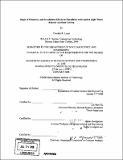| dc.contributor.advisor | Lin-Wen Hu and Jacopo Buongiorno. | en_US |
| dc.contributor.author | Lucas, Timothy R | en_US |
| dc.contributor.other | Massachusetts Institute of Technology. Dept. of Nuclear Science and Engineering. | en_US |
| dc.date.accessioned | 2009-03-16T19:40:35Z | |
| dc.date.available | 2009-03-16T19:40:35Z | |
| dc.date.copyright | 2008 | en_US |
| dc.date.issued | 2008 | en_US |
| dc.identifier.uri | http://hdl.handle.net/1721.1/44768 | |
| dc.description | Thesis (S.M.)--Massachusetts Institute of Technology, Dept. of Nuclear Science and Engineering, 2008. | en_US |
| dc.description | Includes bibliographical references (leaves 66-67). | en_US |
| dc.description.abstract | Nanofluids, colloidal dispersions of nanoparticles in a base fluid, have shown enhancements in both pool boiling and flow boiling critical heat flux (CHF) in laboratory tests. The applicability of this aspect to nuclear reactor post-accident cooling is promising. This study investigates various parameters that should be considered for such applications. Dilute alumina nanofluids were tested in terms of radiation durability, chemical stability, and CHF enhancement capability in wire and plate geometries. They have been found to be stable under high doses of gamma radiation and in the chemical environment associated with emergency core cooling. However, exposure to tri-sodium phosphate, a chemical used in in-vessel retention systems, resulted in significant agglomeration of nanoparticles. CHF value increases were obtained for both nanofluid and primary coolant chemistry conditions. Additionally radiation induced surface activation (RISA) effect on CHF was evaluated for alumina and titania nanoparticle depositions on plate geometries. Pool Boiling experiments were conducted with both wire and plate heaters. Wire test results showed CHF enhancement of 23% to 74% for dilute alumina nanofluids of 0.001v% to 0.1v%, with the highest enhancement obtained for lowest concentration alumina nanofluid. With the addition of boric acid in alumina nanofluid, the highest CHF enhancement is up to 90%. RISA was proven to play a significant role in CHF increase. Stainless steel plates pre-coated with titania and alumina nanoparticles showed CHF enhancement of 146% and 133%, respectively, compared to CHF obtained from plain heaters, after irradiation in a Co-60 gamma source. These initial results reveal that applying nanofluid in reactor chemistry and radiation environment can potentially bring about significant benefit in increasing the safety margin. Further study is needed to elucidate these phenomena in prototypic flow boiling, chemistry, and radiation conditions. | en_US |
| dc.description.statementofresponsibility | by Timothy R. Lucas. | en_US |
| dc.format.extent | 75 leaves | en_US |
| dc.language.iso | eng | en_US |
| dc.publisher | Massachusetts Institute of Technology | en_US |
| dc.rights | M.I.T. theses are protected by
copyright. They may be viewed from this source for any purpose, but
reproduction or distribution in any format is prohibited without written
permission. See provided URL for inquiries about permission. | en_US |
| dc.rights.uri | http://dspace.mit.edu/handle/1721.1/7582 | en_US |
| dc.subject | Nuclear Science and Engineering. | en_US |
| dc.title | Study of chemistry and irradiation effects on nanofluids to be used in light water reactor accident cooling | en_US |
| dc.type | Thesis | en_US |
| dc.description.degree | S.M. | en_US |
| dc.contributor.department | Massachusetts Institute of Technology. Department of Nuclear Science and Engineering | |
| dc.identifier.oclc | 300276718 | en_US |
